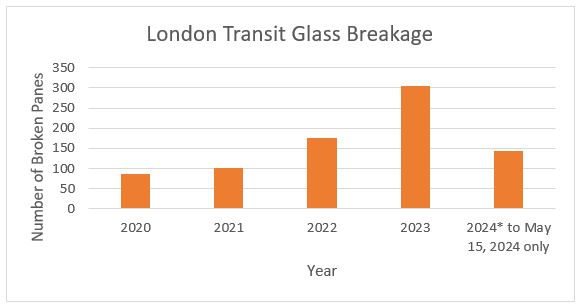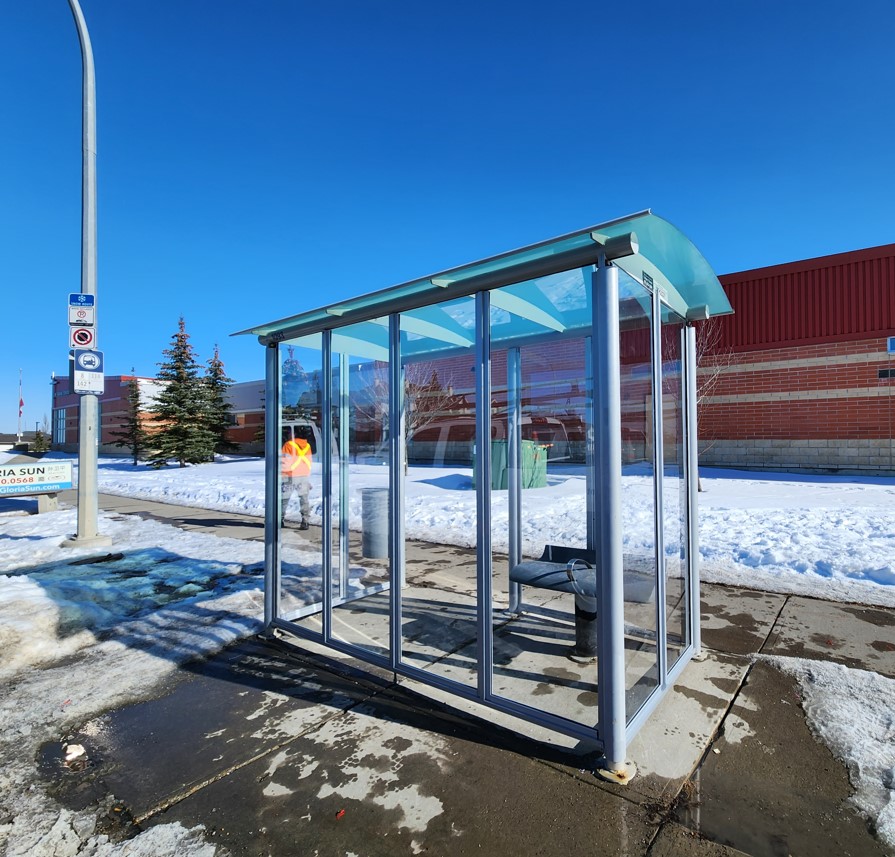Staff Report #7
May 29, 2024
To All Commissioners
Re: Transit Shelter Glass Substitute
Recommendation
The report be NOTED and FILED.
Background
During discussions with OUTEDGE Media on the shelter advertising contract renewal in 2023, concerns were raised with regard to the increased shelter damage being experienced in London. Between 2020 and 2024 the number of panels that were broken doubled. As set out in the Figure I below, the number of panels broken in a given year continues to increase.
Figure I – London Transit Glass Breakage 2020-2024

In light of the continued level of glass breakage occurring in London, administration began assessing alternative options in late 2022. Various vendors have come forward with potential solutions; however, none have worked directly with the shelter manufacturer to determine whether the options they are proposing are viable for existing shelter structures.
The assessment undertaken by administration has included outreach to other transit systems to identify whether any solutions have been identified or are being tested. Calgary Transit is currently piloting an “anti-vandalism” shelter (set out in Figure II below) which uses Plexiglass instead of the traditional tempered glass that is currently used in most transit shelters including those in London. As Plexiglass is less rigid than tempered glass, additional metal extrusions are required to be retrofitted to the existing shelter frame in order to ensure the Plexiglass panel is not easily pushed out or broken. Additionally, concerns have also been raised with respect to the Plexiglass being more flammable, susceptible to yellowing and more likely to experience vandalism in the form of scratching profanity/images.
Figure II – Calgary Transit Anti Vandalism Shelter

The after-market retrofit of the additional support beams to the existing shelter pictured in Figure II cost approximately $14,000, noting a new standard shelter built from regular tempered glass costs approximately $6,000.
In follow up with the shelter contractor, they have indicated that they are working on a “vandalism-proof” shelter design that will incorporate an alternative material to tempered glass and will be purpose built with the requisite support structure. The contractor indicated that they expect to have a final design completed and pricing available later in 2024; however, they did indicate that this new design would be more costly than the current shelters in use in London.
In addition to the Plexiglas alternative, vendors have also come forward with protective film products that can be applied to either tempered glass or Plexiglass which allows for the quick removal of graffiti from the product surface. This would be an additional cost to that for the glass or other product that is installed in the shelter. Vandalism in the form of graffiti, including spray paint, markers, scratching into the glass etc. is not a significant issue in London with approximately 16 instances in 2023 and 39 instances to date in 2024. Generally, this type of vandalism is much easier to address as it can be removed using graffiti cleaners. Very rarely does the damage by this type of vandalism result in the need to replace the glass panels. As such, application of a product of this nature would be an increased cost with no real potential for offset cost savings.
The current contract for shelter advertising includes the requirement of the contractor to clean/maintain/repair all London Transit shelters once every two weeks, or within 48 hours of being notified of damage/excessive garbage, etc. When the contract was renewed in 2023, an upset limit to the number of glass panels (120 per year) that would be replaced under contract was included given the escalating occurrences over the previous number of years. 2024 will be the first full year in which this provision is in place, and the incremental costs associated with this new provision will be tallied in early 2025 as part of the ongoing assessment of alternative options. Once a price for the “anti-vandalism” shelter is known, a detailed cost-benefit assessment can be undertaken to determine the most appropriate path forward.
Given the progress that is being made by the shelter contractor with respect to a purpose-built alternative, administration does not see the benefit in testing a retrofit option in London similar to that being undertaken in Calgary. Any recommendations with respect to a change in the path forward for shelters in London will be set out in a report to the Commission in 2025 which would include the appropriate cost/benefit analysis.
Recommended by:
Katie Burns, Director of Planning
Concurred in by:
Kelly S. Paleczny, General Manager